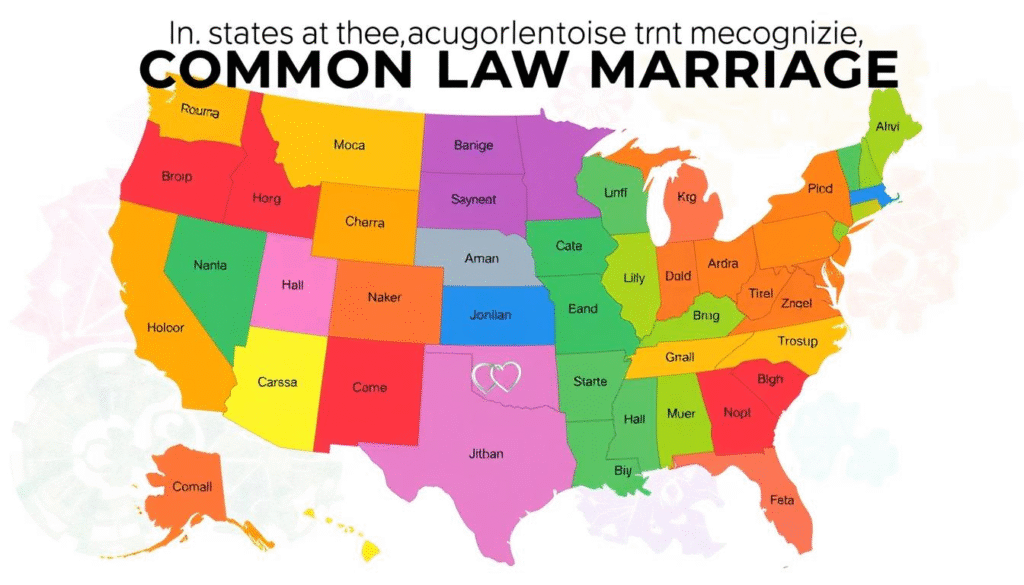Imagine living with someone, building dreams, and creating a home filled with love and laughter. But, you might wonder—what makes a marriage? Common law marriage is a special kind of bond. It’s not just about a wedding or a license. It’s about living together and agreeing to be together.
But, it’s important to know the legal rules that differ from state to state. In this guide, we’ll explore common law marriage. We’ll look at its history and what it means today. By the end, you’ll know how your relationship might be seen by the law and what to do if you choose this path.
Understanding Common Law Marriage
Common law marriage is like traditional marriage but without a formal ceremony. It’s based on certain criteria. Knowing what common law marriage is is key for those living together. Even if people don’t plan to get married, they might accidentally enter into a common law marriage.
Key elements of a common law marriage include:
- Common residence: Partners must live together and share a household.
- Mutual consent: Both parties must agree to be in a marital relationship, showing their intent through words or actions.
- Marriage by habit and repute: The couple must act like they are married to the public, showing they are seen as married by others.
It’s important to understand these points, as different cultures see cohabitation laws differently in the U.S. Legal issues can come up if people claim common law marriage without knowing the rules. So, those in long-term relationships should think about their legal status and what it means for their rights and duties.
Knowing the details of common law marriage helps avoid legal problems. Couples should check how their relationship fits the criteria and talk to lawyers if needed. This way, they can make sure their relationship is legally recognized and protected.

Legal Requirements for Establishing Common Law Marriage
Understanding the legal steps to establish common law marriage is key. Each state has its own rules, but mutual agreement is a common thread. This agreement is more than just saying “I do.” It’s about showing through actions and words that you’re committed to each other.
Living together for a long time is also important. The length of time varies by state. It’s important to know what your state requires. Presenting yourselves as a married couple in public also helps prove your relationship.
Sharing financial duties and owning property together can also help. These actions show you’re serious about your partnership. Keeping records of your shared life, like bills and property, can strengthen your case. This is important for meeting the legal requirements in your state.

States That Recognize Common Law Marriage
It’s key for couples in common law marriages to know the legal rules. Different states have their own rules for these unions. For example, Texas and Colorado just need a verbal agreement and living together to be recognized as married.
Other states look at how long you’ve lived together and if you both want to be married.

Here’s a table showing which states recognize common law marriage and what they look for:
| State | Criteria for Legal Recognition |
| Texas | Requires a declaration of marriage, cohabitation, and representation as a married couple. |
| Colorado | Involves mutual consent, cohabitation, and holding out as a married couple. |
| Illinois | Common law marriage was recognized until 2016, but couples can have legal recognition under certain conditions. |
| New Hampshire | Common law marriages are only recognized for inheritance purposes. |
| Utah | Requires cohabitation for a certain period and the intent to be married. |
Some states no longer recognize common law marriages. This change affects couples living there. Knowing the law can help with rights and duties.
Legal Implications of Common Law Marriage
Common law marriage has big legal effects, similar to traditional marriage. Couples in this type of marriage deal with the same issues as married couples. This includes property rights, inheritance, taxes, and financial duties. Knowing these legal implications helps couples handle life’s challenges together.
In legal fights, like child custody and support, common law marriage matters a lot. Courts see common law couples as legal partners. This gives them rights that unmarried couples don’t have.
Even though some places recognize common law marriage, proving it in court can be hard. In places that don’t, having solid evidence is key. It’s important for couples to keep good records of their life together. This shows the different legal implications of common law marriage and why couples need to be ready.

| Legal Aspect | Common Law Marriage | Traditional Marriage |
| Property Rights | Similar rights to jointly owned property | Automatic property sharing |
| Inheritance | Potential rights without a will | Automatic inheritance rights |
| Tax Implications | May file jointly if recognized | May file jointly |
| Child Custody | Considered legal parents | Considered legal parents |
| Legal Recognition | Varies by state | Widely recognized |
Knowing these details helps common law couples understand their rights and duties. It helps them avoid problems and misunderstandings.
Rights of Unmarried Couples
The legal rights for unmarried couples are changing. It’s important for partners who don’t marry to know about these rights. They can affect things like property, inheritance, and medical decisions in emergencies.
Legal Rights of Unmarried Partners
Unmarried partners have many legal rights. These can include:
- Property Rights: Depending on where you live, you might share property with your partner.
- Inheritance Rights: In some places, you can inherit property without a will if you prove you were partners.
- Medical Decision-Making: You might be able to make health care choices for your partner in emergencies.
Benefits of Common Law Marriage
Common law marriage has many benefits. Unmarried couples should know about these advantages:
- Spousal Support: You might get support like divorced couples in some cases.
- Social Security Benefits: You could get some social security benefits, depending on the situation.
- Protection Under Domestic Abuse Laws: You might get legal help if you’re in an abusive relationship, in some states.
| Rights | Details |
| Property Rights | Shared ownership based on state laws. |
| Inheritance Rights | Right to inherit without a will in some jurisdictions. |
| Medical Decision-Making | Authorized to make health decisions in emergencies. |
| Spousal Support | Potential entitlement similar to that of married couples. |
| Social Security Benefits | Eligibility for benefits similar to spouses. |
| Domestic Abuse Protections | Legal protections available in most states. |
Proof of Common Law Marriage
To prove a common law marriage, you need solid documents and court evidence. Different records can show a couple’s commitment to living together. These records are key to proving their shared life.
Documentation for Legal Recognition
For a common law marriage, certain documents are vital. They prove the couple’s intent to live together:
- Joint bank accounts
- Shared leases or mortgage agreements
- Insurance policies listing each other as beneficiaries
- Shared bills or joint credit card statements
- Affidavits from friends or family attesting to the couple’s relationship
Each document helps prove the marriage, making legal recognition easier.
Testimony and Evidence in Court
In court, testimony is key to proving a common law marriage. Evidence includes written documents and witness statements. These show the couple’s relationship.
Having clear, genuine documents is critical. Courts need detailed proof of the couple’s commitment. Good documentation and testimony are essential for a case’s success.

Understanding Cohabitation Agreements
Cohabitation agreements are key for couples living together but not married. They outline each partner’s rights and duties. This helps in understanding their roles in the relationship.
These agreements offer legal protection. They protect individual assets and income. They also clarify financial and property rights. Without them, couples might face uncertainty in disputes or when they split up.
Here’s a table showing what cohabitation agreements usually cover:
| Component | Description |
| Property Rights | Defines ownership of shared and individual property. |
| Financial Obligations | Details how expenses, bills, and debts will be managed. |
| Personal Matters | Sets expectations regarding household responsibilities and personal conduct. |
| Dispute Resolution | Establishes methods for resolving disagreements amicably. |
| Legal Considerations | Addresses any necessary legal clauses or jurisdictional issues. |
Cohabitation agreements help build a strong partnership. They make managing finances and personal matters easier. It’s wise for couples to make these agreements to protect their relationship legally.
Dissolution of Common Law Marriage
Ending a common law marriage requires specific steps, unlike a traditional divorce. It’s important to know these steps to end your common law marriage. Each state has its own rules for ending a common law marriage, so they can differ a lot.
Legal Procedures for Separation
To start ending a common law marriage, follow these steps:
- File a petition for dissolution in the right court.
- Show proof of the common law marriage, like living together and acting as a married couple.
- Fill out any state-specific forms needed for separation.
- Let the other party know in the way your area requires.
Doing these steps well makes sure both sides are legally recognized during the process.
Rights During Dissolution
During the end of a common law marriage, both sides have certain rights. These include:
- Dividing property fairly, based on what was shared during the relationship.
- Spousal support if one person needs financial help from the other.
- Deciding who gets custody of any children, making sure their needs come first.
Knowing these rights is key, as there can be many challenges during the end of a marriage. Getting legal advice can help deal with these issues and protect your rights.
| Aspect | Dissolution Process | Traditional Divorce |
| Filing Requirements | Petition for dissolution in court | Petition for divorce in court |
| Proof of Marriage | Documents showing cohabitation | Marriage certificate |
| Asset Division | Equitable distribution of shared assets | Equitable distribution or community property laws |
| Spousal Support | Potential for support based on need | Potential for alimony based on various factors |
Common Law Marriage Requirements
To establish a common law marriage, you must meet certain requirements. It’s important for couples to know these to make their partnership legally recognized. Key factors include:
- Mutual Consent: Both individuals must agree to be married and present themselves as a married couple.
- Cohabitation Duration: Couples typically need to live together for a significant period, which varies by state.
- Public Acknowledgment: The couple should be recognized as married by friends, family, and their community.
Different states have different rules for common law marriage. If you’re thinking about this instead of traditional marriage, a checklist can help:
| Requirement | Description | State-Specific Notes |
| Mutual Consent | Both partners must agree to a marital relationship. | Some states may require a specific declaration. |
| Cohabitation | Couples must cohabit; duration varies by state. | In states like Texas, 6 months is common. |
| Public Acknowledgment | Couples need to present themselves as married | Documentation like joint tax returns may help. |
Checking your relationship against these requirements can show your legal status. Knowing these criteria helps ensure you meet local laws for common law partnerships.
Conclusion
Understanding common law marriage is key for unmarried couples. This guide has covered the basics, like what it is, its requirements, rights, and how it ends. Knowing these details can help couples protect their interests and understand their legal rights.
It’s important for partners to know their legal status and rights. This knowledge helps them manage their personal and financial lives better. Because laws vary by state, getting legal advice is a good idea. This way, couples can make smart choices and secure their future together.
FAQ
What is common law marriage?
Common law marriage is when two people live together as a couple without getting married. They don’t need a ceremony or license. It’s based on agreement and living together, with rules that vary by state.
How can I prove my common law marriage?
To prove common law marriage, you need things like joint bank accounts and shared leases. Utility bills and statements from friends or family can also help. These documents are important in court.
What are the legal implications of common law marriage?
Common law marriage gives couples rights like property and inheritance. It also affects taxes and child custody. It’s like a traditional marriage in many ways.
Which states recognize common law marriage?
Some states like Texas, Colorado, and Illinois recognize common law marriage. Each state has its own rules for when it’s considered legal.
What are the requirements for establishing common law marriage?
To establish common law marriage, you need to agree to be married and live together for a while. You should also act like a married couple in public. The exact rules vary by state.
What benefits are associated with common law marriage?
Benefits include spousal support and social security benefits. It also offers protection from abuse. Knowing these benefits helps unmarried couples make informed choices.
How does dissolution of common law marriage work?
Ending a common law marriage involves legal steps that differ from divorce. You must follow state rules for separation. This includes dividing property and deciding on support.
What should be included in a cohabitation agreement?
A cohabitation agreement should cover property, money, and personal matters. It’s a legal way to protect your rights and avoid disputes. It’s useful for unmarried couples.
What are the legal rights of unmarried partners?
Unmarried partners have rights like property and inheritance. They can also make medical decisions for each other. In states that recognize common law marriage, these rights are similar to those of married couples.
How can I ensure compliance with state cohabitation laws?
Knowing your state’s cohabitation laws is key. Couples should learn about the rules for their partnership. Creating a cohabitation agreement can also protect their rights.





